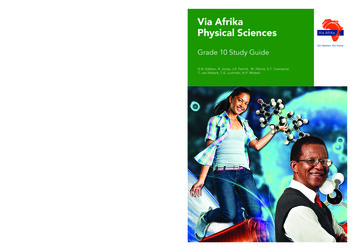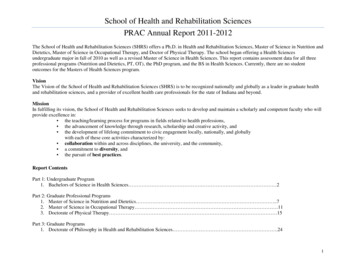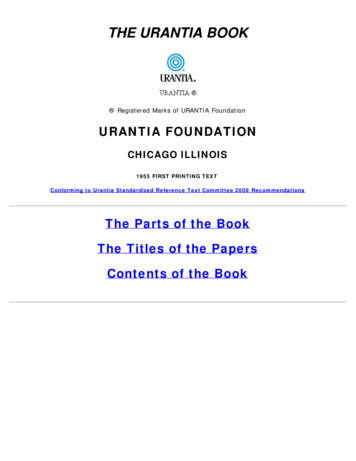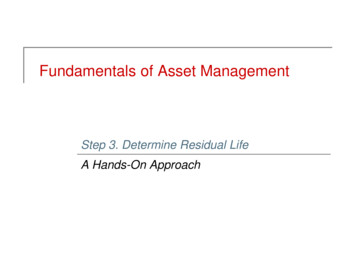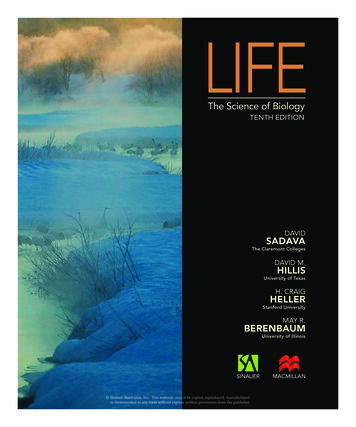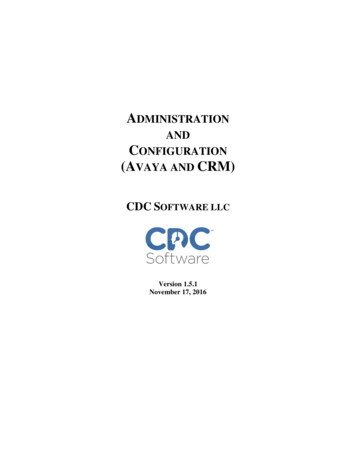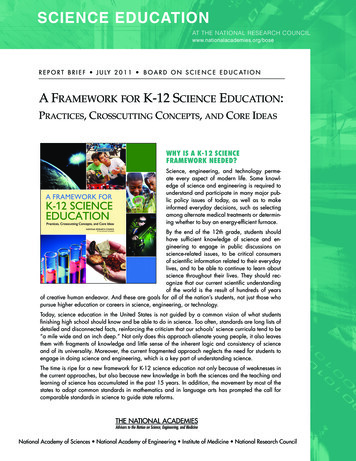
Transcription
For instance, when a learner exits my class and says,“Thank you, Ma’am, for a wonderful lesson.”Grade 10 Teacher’s GuideSome of my greatest rewards are simple ones.— Suzanne Paulsen, Teacher1. The series was written to be aligned with CAPS. See page 4-7 to see how CAPS requirements are met.2. A possible work schedule has been included. See page 4-5 to see how much time this could save you.3. Each topic starts with an overview of what is taught, and the resources you need. See page 34 to find out how this willhelp with your planning.4. There is advice on pace-setting to assist you in completing all the work for the year on time. Page 38 shows you how thisis done.5. Advice on how to introduce concepts and scaffold learning is given for every topic. See page 39 for an example.6. All the answers have been given to save you time doing the exercises yourself. See page 72 for an example.7. Also included is a CD filled with resources to assist you in your teaching and assessment. See the inside front cover.The accompanying Learner’s Book is written in accessible language and contains all the content your learners need to master.The exciting design and layout will keep their interest and make teaching a pleasure for you.We would love to hear your feedback. Why not tell us how it’s going by emailing us at lifesciences@viaafrika.com?Alternatively, visit our teacher forum at www.viaafrika.com.Language: Englishwww.viaafrika.comGrade 10 Study GuideM. Bowie, A. Johannes, R. Mhlongo, E. PretoriusVia Afrika Life SciencesVia Afrika understands, values and supports your role as a teacher. You have the most important job in education, and werealise that your responsibilities involve far more than just teaching. We have done our utmost to save you time and makeyour life easier, and we are very proud to be able to help you teach this subject successfully. Here are just some of the thingswe have done to assist you in this brand-new course:Via AfrikaLife Sciences
M. Bowie A. Johannes R. Mhlongo E. PretoriusStudy GuideVia AfrikaLife SciencesGrade 10ISBN: 978-1-41546-328-4
ContentsIntroduction to Life Sciences. 1Strand 1 Life at the molecular, cellular and tissue level. 7Overview. 7Topic 1 The chemistry of life. 8Topic 2 Cells: the basic units of life.25Topic 3 Cell division: mitosis. 43Topic 4 Plant and animal tissues.52Topic 5 Organs.77Strand 2 Life processes in plants and animals. 86Overview. 86Topic 6 Support and transport systems in plants. 87Topic 7 Support systems in animals. 105Topic 8 Transport systems in mammals (humans). 126Strand 3 Environmental studies. 146Overview. 146Topic 9 Biosphere to ecosystems. 147Strand 4 Diversity, change and continuity. 177Overview. 177Topic 10 Biodiversity and classification. 178Topic 11 History of life on Earth. 190Answers to questions. 215Exam paper 1 and answers.257Exam paper 2 and answers. 270 Via Afrika » Life Sciences Grade 10ii
Introduction to Life SciencesLife Sciences is all about how life on Earth occurs: the principles of life, theirinterconnected systems, and maintaining a stable balance of life in the biosphere.It links with other fields, such as physiology, agriculture, Earth science, physicalscience, mathematics, technology, community health, medicine, population andenvironmental studies, archaeology, anthropology and palaeontology.The Life Sciences have a number of theories that try to explain phenomena and eventsthat occur on Earth. Models are used to explain how processes work and solve problemsusing the accepted basic rules (laws) of cause and effect that have been tried and testedover time.Certain scientific methods, tools and techniques are important in investigating LifeSciences phenomena and are used often in investigations and observations. This iswhat makes studying Life Sciences so exciting. You are able to conduct Life Sciencesinvestigations yourself – at school and at home – to answer your own questions.This study guide works with the activities, hands-on practical tasks, and exercises thatare found in the Learner’s Book.The study guide helps you to check your understanding of the principles of the LifeSciences, to practise your scientific skills and to solve modern Life Sciences problemsand issues with what you know. In doing so, it prepares you for your class tests andexaminations.Attempting the questions in this study guide helps you recognise the kinds of questionsyou can be asked. It also challenges you to practise difficult questions, solve problemsand recognise the issues – how they affect not only you but also life around you on theever-changing planet Earth. Via Afrika » Life Sciences Grade 101
1 Purpose of studying Life SciencesTo best understand the Life Sciences, you will need to practise questions associatedwith:1 Scientific knowledge and understanding2 Science process skills (scientific investigations)3 Understanding of the roles of science in society.1.1 Knowing and understanding scientific knowledgeThis aim is achieved through:1.1.1 Acquiring knowledgeIn the process of acquiring knowledge you must: access information from a variety of sources select key ideas recall facts describe concepts, processes, phenomena, mechanisms, principles, theories, lawsand models in the Life Sciences.1.1.2 Understanding, comprehending, making connections between ideas and concepts to make meaning of Life SciencesIn the process of making meaning and achieving understanding you must: build a conceptual framework of science ideas organise or reorganise knowledge to derive new meaning write summaries develop flow charts, diagrams and mind maps recognise patterns and trends.1.1.3 Applying knowledge of Life Sciences in new and unfamiliar contextsYou must be able to: apply knowledge to new and unfamiliar contexts use information in a new way.1.1.4 Analysing, evaluating and synthesising scientific knowledge, conceptsand ideasIn the process of learning science you must be able to: analyse information/data recognise relationships between existing knowledge and new ideas critically evaluate scientific information identify assumptions categorise information. Via Afrika » Life Sciences Grade 102
1.2Investigating phenomena in the Life SciencesThis aim is achieved through a range of skills that relate to doing practical work in LifeSciences. You must be able to:1.2.1 Follow instructions – during investigations1.2.2 Handle equipment or apparatus – use laboratory or improvised equipment appropriately and safely1.2.3 Make observations – make and record different kinds of observations in differentways: drawings; descriptions; grouping according to similarities and differences;measurements; comparisons of materials before and after treatment; observingresults; counting and recording information in an appropriate way1.2.4 Record information or data – make drawings; descriptions; simple tables; single graphs1.2.5 Measure – know what to measure, how to measure it, have a sense of the degreeof accuracy that is required for: volume; temperature; mass/weight; counting ofnumbers and making estimates1.2.6 Interpret – know how to convert information from one form into another – tabulated data into an appropriate graph; perform appropriate simple calculations;analyse and extract information from tables and graphs; apply knowledge oftheory to practical situations; recognise patterns and/or trends; appreciate thelimitations of experimental procedures; make deductions based on evidence1.2.7 Design or plan investigations or experiments – plan or design a simple investigation or experiment: identify a problem, formulate an hypothesis; selectapparatus or equipment and/or materials; identify variables; suggest ways ofcontrolling variables; plan an experiment; suggest ways of recording results;understand the need for replication or verification.1.3 Appreciating and understanding the history, importance andapplications of Life Sciences in societyThis aim is achieved through:1.3.1 Understanding the history and relevance of some scientific discoveries – knowing particular discoveries or scientists associated with the topics and content1.3.2 Understanding the relationship of indigenous knowledge to Life Sciences –knowing, understanding and appreciating the different cultural contexts inwhich indigenous knowledge systems were developed, shaped by different worldviews, compared to modern science and technology1.3.3 Understanding the value and application of Life Sciences knowledge in industry,in respect of career opportunities and in everyday life – knowing, understandingand appreciating the applications and relevance that knowledge of Life Scienceshas found in various aspects of society associated with the topics and content. Via Afrika » Life Sciences Grade 103
2 Concept maps (graphic organisers)A graphic organiser or concept map is a useful tool in summaries and for understandinghow topics learnt are related to each other. It also allows you to relate the informationlearnt to new information being obtained through creating the necessary links andassociations.While working through the associated topics, create and/or complete the concept mapsprovided to produce a study summary of the topic and strand.Concept maps and graphic organisers are also useful in structuring responses toparagraph and essay type questions.3 Formal assessment tasks for the yearYou will be required to perform the following assessment tasks during the year: Hands-on practical investigations Research assignments Class tests June examination November examination November Practical examination.4 Understanding assessment tasks and questionsYou should not be scared of class tests, practical tests and examinations, and practicalexaminations. Preparing for assessment tasks involves: understanding what the tasks need you to do recognising what kind of thinking each question is testing recognising the question words and what they require.All of this can be achieved through regular practice in being able to recognise what aquestion asks of you. The following information is provided to help you understandwhat each question in any assessment task needs you to do. Via Afrika » Life Sciences Grade 104
4.1 Understanding what kind of thinking assessment tasksmeasureEach assessment task wants to know if you: know and can remember information that you have learnt understand and can explain the information that you have learnt can analyse and solve everyday problems using what you have learnt can analyse, can integrate information to understand the cause and effect ofchanges and can evaluate information for limitations, accuracy and bias.Your examination paper will cover these areas as shown below.Weighting of thinking levels for assessment and associated verbs used inquestionsThinking levels% ofexaminationpaperVerbs used inquestionsKnowing scienceUnderstandingscienceApplying ng scientificknowledge40%25%20%15% state name label list define describe identify measureand others predict apply use knowledge demonstrate determine / solve implement judge estimateand others explaincomparerearrangegive an exampleof illustrate calculate make ageneralisation outline contrast tabulateand others sscategorise/classify evaluateand others It is important for you to practise questions across all of the thinking levels. Manyquestions go beyond simply remembering facts to see if you can solve problems that youwill encounter during your life. Via Afrika » Life Sciences Grade 105
4.2 Common verbs used in Life Sciences assessment questions orinstructionsHere are words and expressions that you may come across in formal assessment tasksare listed below – make sure that you know their meaning too so that you know what isexpected of you: categorise – group or organise according to similarities or differences; use criteria differentiate – use differences to qualify categories give an example of – requires a concise answer with little or no supportingargument implement – use label – identify on a diagram or drawing make a generalisation – provide an overview statement that explains a trend orrepresents an overall comment name – identify rearrange – reorganise according to certain criteria in a logical way select – choose solve – determine or find use knowledge – make use of given information to work out a result, predict anoutcome, or explain an observation Via Afrika » Life Sciences Grade 106
StrandStrandX1Life at the molecular, cellular and tissue levelOverviewTOPIC 1Page 8–24The chemistry of lifeTOPIC 2Page 25–42Cells: the basic unitsof lifeSTRAND 1Page 7–85Life at the molecular,cellular and tissue levelTOPIC 3Page 43–51Cell division: mitosisTOPIC 4 Page 52–76Plant and animaltissuesTOPIC 5 Page 77–85Organs Molecules for life – organic and inorganiccompounds Inorganic compounds Organic compounds The Recommended Dietary Allowance of nutrients The cell is discovered using the microscopePlant and animal cellsThe cell membraneThe cell nucleus and endoplasmic reticulumCell cytoplasm and organellesCell differentiation The growth and division of a cellMitosisCancer Tissues Plant tissues Animal tissues Indigenous knowledge and biotechnology Plant organs Plant leaves Structures and related functions of a plant leaf Movement of substances to and from the leaf Regulation of gas by stomataAll living organisms are made of atoms that combine to form molecules, and thesemake up the basic units of life: cells. Cells are grouped together and organised to formtissues, organs and systems that make up large organisms. Each part performs a specificfunction for the living organism in order to keep it alive. This strand introduces you tolife at the molecular, cellular and tissue level. Via Afrika » Life Sciences Grade 107
Topic1The chemistry of lifeOverviewLiving organisms depend on inorganic and organic compounds from the naturalenvironment as life-giving resource materials to build and maintain their cells, tissues,organs and body forms.Molecules for l saltsMacro elementsMicro elementsProteinsEnzymesNucleic acidsVitamins1 Molecules for life – inorganic and organic compounds Matter is made up of atoms of the elements.Atoms are joined to form molecules through chemical bonds.A molecule is any chemical structure made of atoms, held together by bonds.A compound is a chemical substance made up of atoms of two or more elements.1.1 Matter is made of organic and non-organic substances All living and non-living matter is made up of organic and inorganic substances.Inorganic and organic compounds are found as mineral elements (salts) andmolecules; table salt is NaCl, a combination of sodium (Na) and chloride (Cl).2 Inorganic compounds Inorganic compounds are made by natural geo-physical processes in theenvironment.They form in living organisms as part of metabolism, in metabolic reactions.Examples are water, carbon dioxide, oxygen, sulphur dioxide gas and sodiumchloride (table salt). Via Afrika » Life Sciences Grade 108
Topic2.11WaterWater (H2O) is used: to dissolve substances (solvent) to transport substances in the external and internal environments as a substance (medium) for chemical reactions to occur in to control temperature for support and structure in reproduction.2.2 Mineral elements for animals and humans Mineral elements (minerals) are inorganic, and naturally found as salts in theexternal environment.Macro mineral elements – those needed in large quantitiesMicro mineral elements – those needed in small quantities (trace elements); takenup as salts (ions)Macro mineral elements needed by humans: sodium (Na), potassium (K),calcium (Ca) and phosphorus (P)Micro mineral elements needed by humans: iron (Fe), iodine (I)Lack of macro and micro minerals can cause deficiency diseases.2.3 Mineral elements needed by plantsPlants need mineral elements for their metabolic processes.They are taken up as salts (ions) from the soil.2.3.1 Macro mineral elements needed by plants Macro mineral elements needed by plants: nitrogen (N), phosphorus (P),potassium (K), calcium (Ca), magnesium (Mg), sulphur (S) and iron (Fe)Nitrogen and phosphorus are taken up as nitrates and phosphates.Nitrogen enters roots as nitrate in soil – from humus decomposition, animal faecesand urine, nitrogen-fixation, adding fertiliser (nitrate or ammonia).Phosphorus enters roots as phosphates – from humus decomposition, animalfaeces and urine, mineralisation processes of rock, adding phosphate fertiliser(phosphates).2.3.2 Micro mineral elements needed by plantsMicro mineral elements needed by plants: boron (B), copper (Cu), iron (Fe),chlorine (Cl), manganese (Mn), molybdenum (Mo) and zinc (Zn) Via Afrika » Life Sciences Grade 109
Topic12.4 Fertilisers Fertilisers supply plant nutrients or they correct soil fertility, where years of farmingor over-using has removed nutrients.They are the most effective way to improve crop yields, quality of food and fodder.The major nutrients in fertilisers are nitrogen, phosphorus and potassium.Nitrates – supply nitrogen Organic forms: plant matter, manure, sewage, food wastes, or any nitrogenousorganic compound Inorganic forms: nitrate or ammoniaPhosphates – supply phosphorus Organic forms: plant matter, manure, sewage, food wastes Inorganic forms: phosphate or superphosphateToo much inorganic fertiliser can harm a humus-depleted soil. The soil becomesoverloaded with urea, nitrates and phosphates – these leach into surface water.Organic fertiliser can bring back natural fertility.2.4.1 Leaching of agricultural fertilisers into groundwater, rivers and dams Water movement leaches phosphate out of soil, often leaving too little for healthyplant growth.Huge amounts of fertiliser are lost through surface run-off and leaching into groundwater.Excess fertilisers/nutrients in water bodies removes oxygen, and animals and plantsin the water die.2.4.2 Eutrophication Eutrophication occurs when nitrogen-rich compounds in fertiliser run off and causelack of oxygen in water bodies, especially coastal zones.Without dissolved oxygen they cannot support plant and animal life.The water also becomes cloudy and discoloured causing decreased photosynthesisand cold temperatures. Via Afrika » Life Sciences Grade 1010
Topic13 Organic compounds Organic compounds are made through chemical reactions in living organisms; theyare nutrient and energy sources.They are made of molecules and contain carbon, hydrogen and oxygen; some maycontain nitrogen, sulphur and phosphorus.Examples are: carbohydrates, lipids, proteins (including enzymes), hormones,nucleic acids and vitamins3.1 CarbohydratesCarbohydrates are made from the elements carbon, oxygen and hydrogen.They are used to: store energy – starch in plant cells; glycogen in animal muscle cells provide energy – during cellular respiration in the mitochondrion provide structure and protection – cell wall in plant cells.Table 1.1 Carbohydrates grouped according to e (mono) sugarmoleculesglucose and fructoseDisaccharidestwo (di) sugar moleculesjoinedmaltose and sucrosePolysaccharidesmany (poly) sugar moleculesjoinedstarch, cellulose, glycogenStarch (polysaccharide) testThe starch test uses iodine solution to show the presence of starch:Positive blue-black colour; Negative yellow-orange colour.3.1.2 Glucose tests Fehling’s A and B test for glucose: positive green, yellow, orange, red colour;negative blue colour.Benedict’s test for glucose: positive brick-red colour; negative blue colour.3.2 LipidsLipids are fats and oils.They are organic molecules made of carbon, oxygen and hydrogen.Made of: one glycerol molecule joined to three fatty acid molecules.Saturated lipids (fats) – are from animals, are solids, have single bonds betweenatoms; examples: lard and butterUnsaturated lipids (oils) – are from plants, are liquids, have double bonds betweensome of the atoms (mono-unsaturated and poly-unsaturated lipids); examples: oliveoil, cod liver oil, sunflower oil and margarine Via Afrika » Life Sciences Grade 1011
Topic 1Uses of lipids: provide structure – as phospholipids in cell membranes absorb nutrients – vitamins A and D store energy – oils in plant seeds provide insulation – fat layers under the skin prevent heat loss protect organs from shock and movement – layers around internal organs provide water – e.g. a camel hump is broken down to water in drought provide waterproofing – wax layers (cuticles) on plant surfaces3.2.1 Lipid tests Lipid tests for fats and oils use their ability to dissolve in solvents; lipids dissolve inether and do not mix in water (immiscible).Ether test: positive translucent oil mark on paper; negative no oil markWater test: positive immiscible (oil floats on water); negative miscible3.3 CholesterolCholesterol is a lipid (sterol); it is made and used by bodies to keep healthy.Cholesterol digests fats and makes vitamin D and hormones.Cholesterol comes from both your body and the animal products you eat.There are three types of cholesterol: low-density lipoprotein (LDL) – known as ‘bad’ cholesterol high-density lipoprotein (HDL) – known as ‘good’ cholesterol triglycerides.Lipoproteins carry cholesterol through the body as it cannot dissolve in blood.When you eat fat, the liver converts it to a lipoprotein, which is carried through thebody as low-density lipoprotein (LDL).3.3.1 LDL cholesterol and genetic LDL cholesterol Too much LDL in the blood slowly builds up plaque in the arteries that go to theheart and brain.Plaque is a thick deposit that makes arteries narrow and hard – a condition calledatherosclerosis.The arteries can block up, causing a heart attack or stroke.A high level of genetic LDL cholesterol means a person is more likely to get fatdeposits at a younger age.3.3.2 HDL cholesterol HDL in blood prevents a heart attack.It carries cholesterol away from arteries to the liver for excretion.It removes cholesterol from plaque. This slows plaque build-up. Via Afrika » Life Sciences Grade 1012
Topic3.4 1TriglyceridesTriglyceride is a fat made in the body.High levels in the blood are caused by being overweight, a high-carbohydrate diet,no exercise, smoking, and drinking too much alcohol.People with high triglycerides often have a high LDL level and a low HDL level.Many develop heart disease and/or diabetes.3.4.1 Total cholesterol count The two types of lipids, HDL and LDL, along with triglycerides and genetic LDL,make up your total cholesterol count.It can be determined through a blood test.3.5 ProteinsProteins are organic compounds made from carbon, oxygen, hydrogen and nitrogen;some may contain phosphorus, sulphur and iron.They are made of 20 different kinds of amino acids, which are sequenced in aspecific order.Proteins are fibrous, globular and membrane-bound.Proteins are classified by size and the number of amino acids they contain: amino acids: 1 molecule – tryptophan, glycine, alanine dipeptides:2 joined amino acids – aspartame (artificial sweetener) tripeptides:3 joined amino acids – glutathione (anti-oxidant) peptones:4–10 joined amino acids – peptone, tryptone polypeptides: 10–50 joined amino acids – digested parts of proteins proteins:50 or more joined amino acids – albumen, gelatine.Proteins have four kinds of unique structure: primary structure – the sequence of amino acids joined together secondary structure – the way the chain is folded (pleated) or coiled (spiral) tertiary structure – the fibrous or globular shape of the protein polymer quaternary structure – two or more proteins joined together.Proteins are denatured when the amino acid chains or structure of the proteinchanges under heat, pH and salt.Uses of proteins: store potential energy source of amino acids provide structure provide support transport co-ordinate chemicals as hormones provide protection as antibodies speed up metabolic reactions as enzymes allow movement through membranesA continual lack of protein in a daily diet causes the diseases kwashiorkor or marasmus. Via Afrika » Life Sciences Grade 1013
Topic13.5.1 Protein tests Millon’s reagent test: positive wine red colour; negative white/cream colourBiuret test: positive violet to purple colour; negative blue colourThe Biuret test uses sodium hydroxide and copper sulphate solution – these areadded to the test tube directly and heated.3.5.2 Factors that affect protein structureFactors that denature proteins and affect how they function are:high temperature (not low) extreme acidity or alkalinity (pH concentration) high salt concentration. 3.6 EnzymesEnzymes are organic compounds with a specific structure, and are made fromcarbon, oxygen, hydrogen and nitrogen; some of them contain sulphur.They are modified proteins.Enzymes: may change shape during a reaction but this is not permanent are not used up or destroyed during metabolic chemical reactions function best in certain specific optimum conditions act on a specific substrate (substance) break down or build (synthesise) molecules.The functions of enzymes are to: perform building-up (anabolic) and breaking-down (catabolic) reactions control specific reactions due to their shape and chemical structure act as catalysts that control the rate of metabolic reactions in organisms bylowering the energy needed for the reaction.An example of an important enzyme in cells is catalase (peroxidase). Hydrogenperoxide endangers metabolic reactions in a cell, but catalase breaks downhydrogen peroxide to form oxygen gas and water (bubbles):hydrogen peroxide2H2O2 water2H2Oand oxygen gas O23.6.1 Factors that affect enzyme action The rate of an enzyme reaction and its efficiency is influenced by: temperature pH concentration nature and amount of the substrate amount of enzyme. Via Afrika » Life Sciences Grade 1014
Topic1 Temperature affects enzyme action in the following ways: low – molecules have low kinetic energy; enzymes become inactive optimum – maximum enzyme activity high – protein structure of enzymes is denatured; activity stops.Enzymes are denatured when their amino acid chains begin to come undone orrefold and the shape of the active site changes. Concentration of pH affects enzyme action in the following ways: low – protein structure of enzymes becomes denatured; activity stops optimum – maximum enzyme activity high – protein structure of enzymes becomes denatured; activity stops.Enzymes are denatured when acidity causes the active site to change shape.3.6.2 Enzymes in everyday life Enzymes are added to washing powders to break down stain molecules.Different enzymes are used: proteases – break down proteins (blood, egg, gravy) amylases – break down starches lipases – break down fats and grease.Most washing powders contain one type of enzyme, but some have two or all three.3.7 Nucleic acidsNucleic acids are large, organic molecules made of carbon, hydrogen, oxygen,nitrogen and phosphorus.Two types exist in cells: DNA (deoxyribonucleic acid): in the nucleus; stores information to make protein RNA (ribonucleic acid): in the nucleus and on ribosomes in the cytoplasm; helpsto make proteins from amino acids.3.8 Vitamins Vitamins are organic compounds.They help control metabolic reactions and are part of a healthy diet.Table 1.2 Deficiency diseases caused by lack of vitaminsDeficiency diseaseVitaminVitamin AVitamin B(complex)Vitamin CVitamin DMain sourcefish oil, dairy products, yellow vegetablesnight blindnesslegumes, nuts, cereals, grains, egg yolk, liverberiberi, pellagracitrus fruit, tomatoes, vegetablesdairy, egg yolk, liver, made in skin using sunlightVitamin Ecereals, seeds, oils, green leafy vegetablesscurvyricketsnerve problems, immunedisorders Via Afrika » Life Sciences Gr
All the answers have been given to save you time doing the exercises yourself. See page . 72. for an example. 7. Also included is a CD filled with resources to assist you in your teaching and assessment. See the inside front cover. The accompanying Learner’s Book is written in accessibl
